tags: researchblogging.org, supermouse, Phosphoenolpyruvate Carboxykinase, PEPCK-C, glucose metabolism
Like a Lance Armstrong equivalent among ordinary mice, a group of American scientists report that they altered a single gene involved in glucose metabolism in a mouse and discovered that this genetically altered mouse demonstrates remarkable athletic abilities. For example, this supermouse runs 20 meters per minute for five hours or more without stopping -- a distance of 3.7 miles (6 kilometers)!
"They are metabolically similar to Lance Armstrong biking up the Pyrenees. They utilize mainly fatty acids for energy and produce very little lactic acid," said Richard Hanson, professor of biochemistry at Case Western Reserve University in Cleveland, Ohio. Lactic acid causes muscle cramps. Interestingly, this metabolic characteristic is shared with the best human endurance athletes.
The bioengineered mice also live longer, consume 60 percent more food without getting fat (below), have more sex and are capable of reproducing up to three times the normal maximum age, and are ten times more active than normal mice, according to the research paper.
The mice were altered so they overexpress the gene that encodes the metabolic enzyme called phosphonenolpyruvate carboxykinase (PEPCK-C) -- a gene shared with humans.
"We humans have exactly the same gene. But this [experiment] is not something that you'd do to a human. It's completely wrong," asserts Hanson. Hanson led the team of 15 research scientists. Further, "it is currently not possible to introduce genes into the skeletal muscles of humans and it would not be ethical to even try."
The stated purpose of this research was to gain a greater understanding of PEPCK-C, an enzyme that is expressed primarily in the liver and kidneys. But the team's genetically-altered mice produce up to 100 times more of this enzyme than ordinary mice, and unlike ordinary mice, this enzyme was expressed in high levels their muscles.
Based on this research, it is possible that pharmaceutical companies might explore these findings to develop new drugs that enhance muscle performance. Such drugs may benefit certain patients, such as those suffering from cystic fibrosis.
To identify whether experimental animals' genes have been successfully altered, scientists must conduct a variety of tests, but according to Hanson, these mice were noticeably different at a very early age: they showed both physical and behavioral changes.
"We could spot them at just a few weeks after birth," Hanson said. "They popped around the cage like popcorn. We found that they were about 10 times as active as ordinary mice." (See below)
After breeding a colony of 500 of these supermice, the researchers have noticed that these metabolic and behavioral changes persisted into adulthood.
"They eat twice as much as control mice, but they are half the weight, and are very aggressive," noted Hanson. "Why this is the case, we are not really sure."
This was published yesterday in the Journal of Biological Chemistry.
Sources:
Parvin Hakimi, Jianqi Yang, Gemma Casadesus, Duna Massillon, Fatima Tolentino-Silva, Colleen K. Nye, Marco E. Cabrera, David R. Hagen, Christopher B. Utter, Yacoub Baghdy, David H. Johnson, David L. Wilson, John P. Kirwan, Satish C. Kalhan, and Richard W. Hanson. Overexpression of the Cytosolic Form of Phosphoenolpyruvate Carboxykinase (GTP) in Skeletal Muscle Repatterns Energy Metabolism in the Mouse. Journal of Biological Chemistry. 2007; 282: 32844-32855 [PDF].
The Independent (quotes).

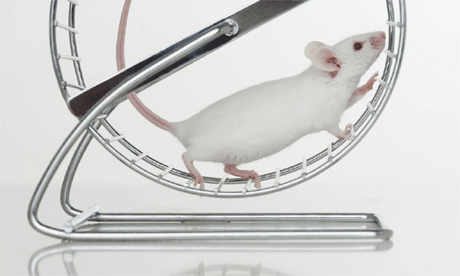
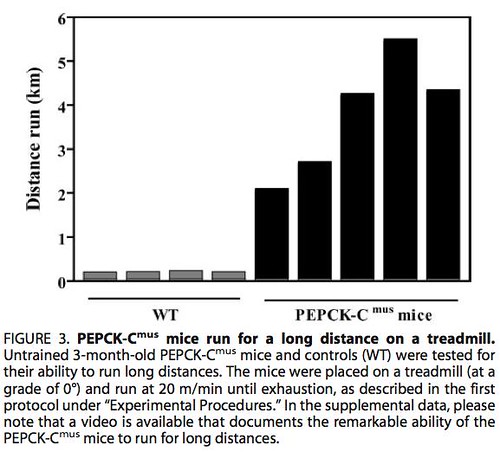
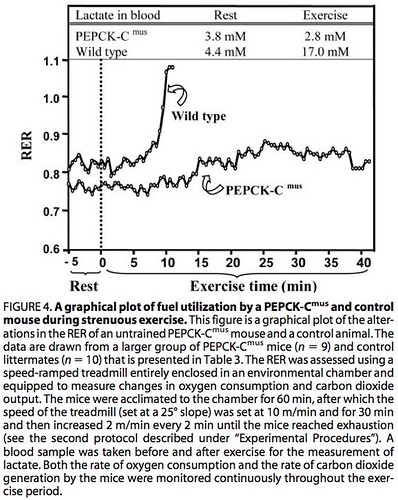
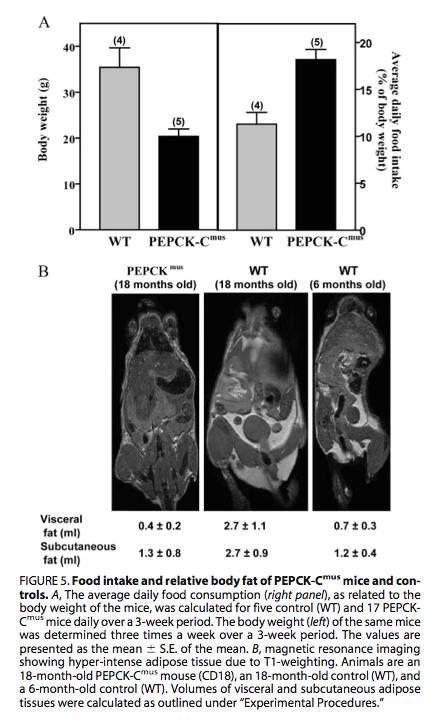
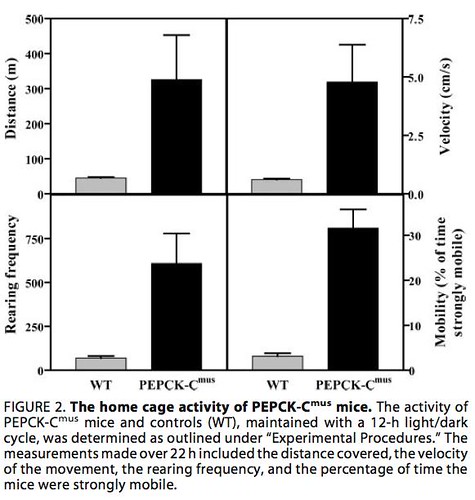
I guess that means the gene produces EPO too. Allegedly.
There's some wacky research coming from one of the group here that showing fitness effects of PGI (phosphoglucose isomerase) in butterflies. This is wacky because the gene is involved in glycolysis, so is a vital part of metabolism.
Bob
I, for one, welcome our supermice overlords...
I saw a similar article. What they burried way down in the article is that the mice are also much more aggresive than normal
Astounding; any idea why this didn't make Nature or Science?
I'm wondering what the trade-off is here. If these mice are stronger, faster, and better reproducers, why hasn't this mutation already become dominant? I have a hard time believing that researchers stumbled upon the one! genetic change that makes mice into "supermice." If it was that simple, it would have already happened, i think.
Perhaps the tradeoff are the aggresiveness, they are more prone to kill offspring, mates, and get wounded being more vulnerable to predators or diseases...
yes, aggressiveness, and also the fact that these mice consume 60 percent more food than a regular mouse does would also be bad for the ultimate survival of this mutation.
Certainly, and Mus musculus did not evolve in a semiarid environment?